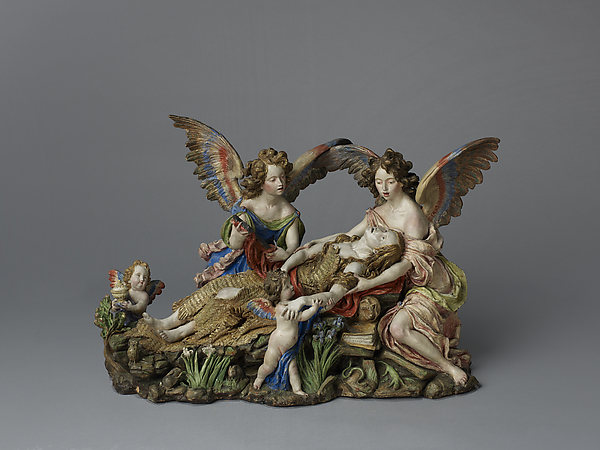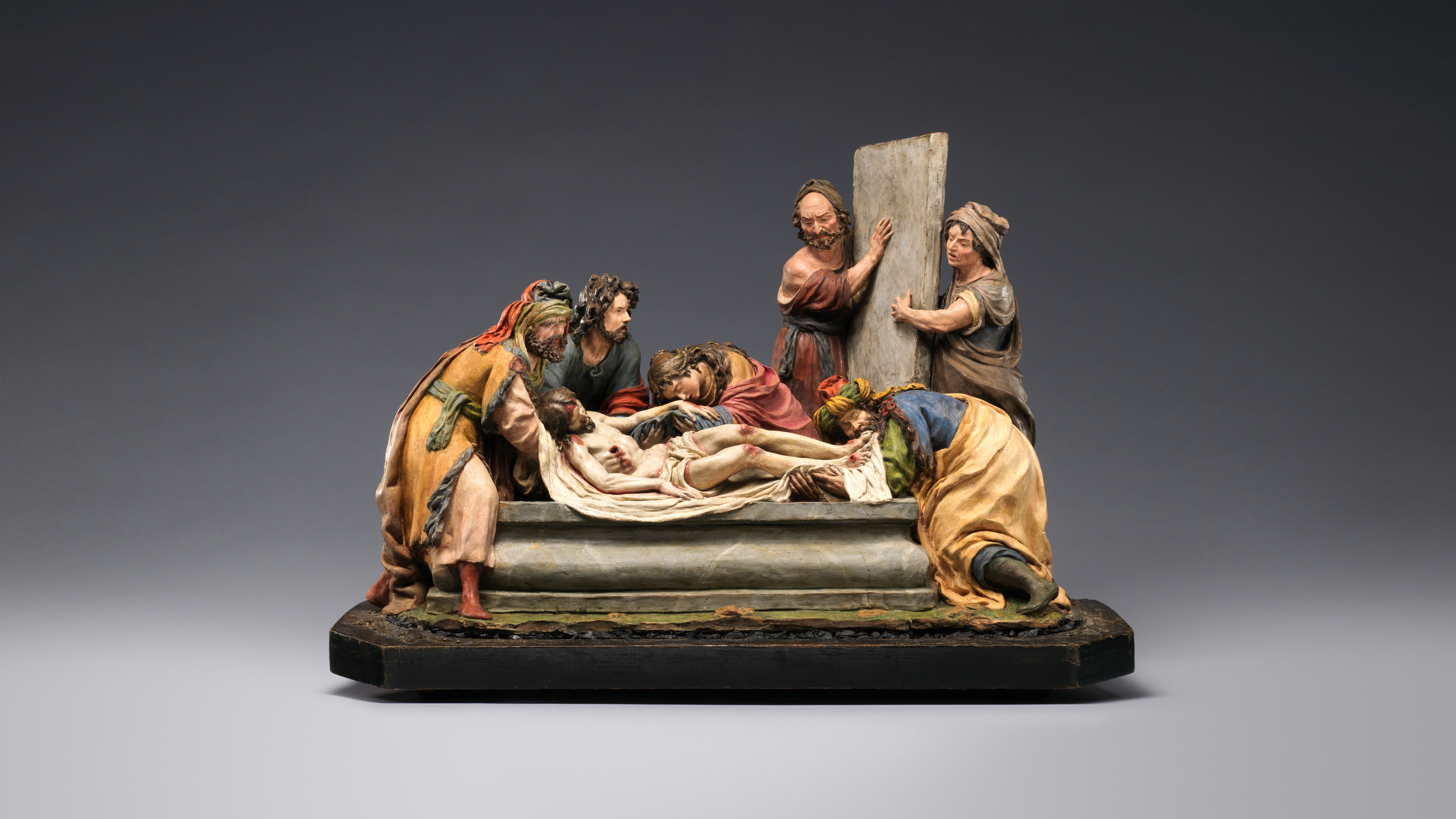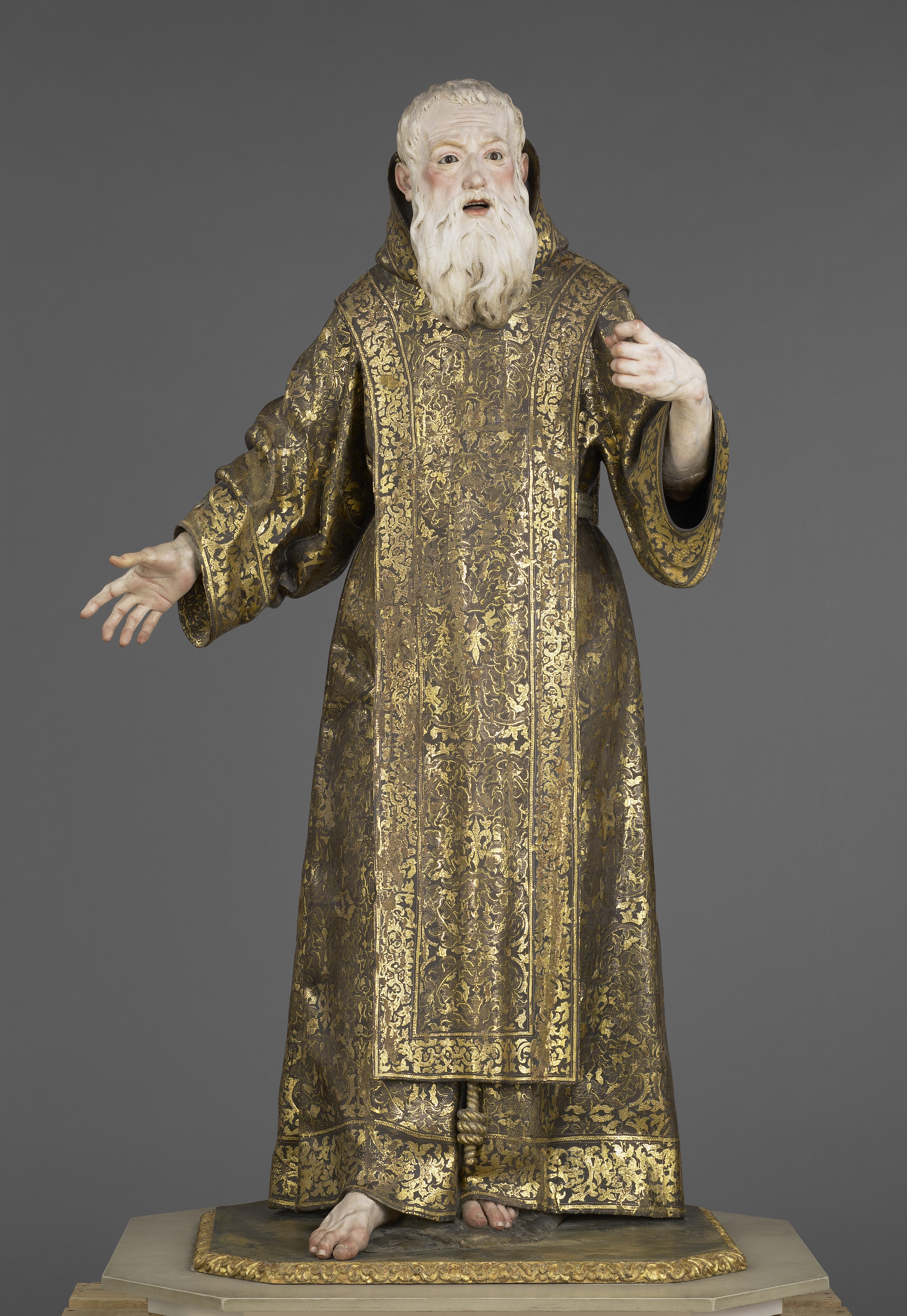Luisa Roldán
Active in: Spain
Alternate names: La Roldana
Biography
Luisa Roldán was one of eight children born to the sculptor Pedro Roldán (ca. 1624–ca. 1700), and his wife, Teresa de Jesús Ortega y Villavicencio, who he married in 1642. By the time Roldán was born, her father had become one of Seville’s most renowned sculptors. Unable to attend the Academia de Bellas Artes, where her father was a professor of sculpture, Roldán studied with him privately, as did her siblings Francisca (b. 1650), Maria (b. 1654), Isabel (b. 1657), Teresa (b. 1660), Ana Marcela (b. 1662), Marcelino (b. 1662) and Pedro (b. 1665). As his children became proficient, Pedro Roldán engaged them in his growing workshop. The collaborative nature of carving and painting large wood sculptures to create the complex, often multipaneled altarpieces (retablos) favored in Spain required studio assistants to specialize. Roldán’s specialty is not known, but she became the most celebrated of the Roldán family of sculptors, fully conversant with all the aspects of carving wood, preparing it for color, and the collaborative nature of a workshop. There is no evidence that her father’s workshop ever produced terracotta figures, something that Roldán is credited with developing on her own.
In 1671, Roldán married Luis Antonio Navarro de los Arcos, her father’s pupil, despite her parents’ objections. Together they had seven children, but just two survived into adulthood. After her marriage Roldán established an independent studio, collaborating with her husband – she completed the carving while he undertook the painting. Their collaboration included commissions from various confraternities in Seville for the traditional Holy Week float. These floats included groups of life sized carved and polychromed wooden figures depicting the stages of Christ’s Passion. De los Arcos signed these works, while Roldán rarely added her signature.
Between 1684 and 1687, Roldán spent considerable time in Cádiz, receiving commission from the cathedral for several large wooden polychrome sculptures, including various angels, prophets, and virtues. The town council of Cádiz also commissioned Roldán to create polychrome wood sculptures of the town’s patron saints Servandus and Cermanus. Her various representations of Christ and other related male biblical characters established her as one of the few female artists of this time who created images of nude or semi-nude male figures.
Hoping to secure an appointment as court sculptor, Roldán and her family left Cádiz in 1688 or 1689 and settled in Madrid. There, she continued to work on large scale wooden sculptures, while also developing her small scale, polychrome terracotta figures. Less expensive to make, easily replicated from a mold, and more affordable for buyers, Roldán’s new work represented a response to the different attitude towards sculptors in Madrid. Unlike in Seville or Cádiz, makers of large-scale polychromed wooden sculptures in Madrid were regarded as craftsmen instead of fine artists. Roldán’s smaller works, with their delicacy and intimacy, were judged by different standards. By virtue of their smaller size, these terracottas were entirely distinct from the large workshop-produced retablos. Given Roldán’s role in pioneering such works, they must have become a welcome novelty and were eagerly collected by numerous patrons who lived in Madrid. Given the number of Roldán’s terracotta works that survive, they were likely treasured as private devotional objects.
By 1692 King Charles II (1661–1700) recognized Roldán’s accomplishments, appointing her as a court sculptor with the title Escultora de Cámara in that year. Roldán began to sign her works with this title, but the position was far from lucrative. Roldán had to campaign to be granted a salary and then had difficulty collecting from her patrons at court. King Charles II died on November 1, 1700, and was succeeded by King Philip V (1683–1746). Having made a special presentation to the new king, Roldán’s position as a court sculptor was renewed and she was awarded the title Escultora de su Majestad. King Philip V proved to be less enthusiastic patron of the arts and he is not known to have undertaken any major commissions during his reign. Roldán was destitute at her death in Madrid on January 10, 1706. Her legacy was secured by 1724, when the painter Antonio Palomino (1655–1726) wrote about her in his treatise El parnaso español pintoresco laureado – of the 226 artists described, she was one of just two women and Palomino described her work with unqualified appreciation and praise.
Selected Works

Luisa Roldán and Luis Antonio de los Arcos, Cavalcade of the Three Kings, ca. 1670–89. Polychrome cedar wood, clay, varying size. Museo Nacional de Escultura

Luisa Roldán, The Ecstasy of Saint Mary Magdalene, ca. 1690. Polychromed terracotta, 30.5 x 44.5 x 25.1 cm. The Hispanic Society Museum and Library.

Luisa Roldán, The Education of the Virgin, 1680s. Polychromed wood, 76 x 63 x 43 cm. Los Angeles County Museum of Art.

Luisa Roldán, The Entombment of Christ, 1700–01. Polychromed terracotta, 49.5 x 66 x 43.2 cm. Metropolitan Museum of Art.
Circle
Daughter of
Pedro Roldán (c. 1624-1700)
Wife of
Luis Antonio Navarro de los Arcos
Bibliography
Alvarez, Mari-Tere. “The Reattribution of a Seventeenth-Century Spanish Polychrome Sculpture.” The J. Paul Getty Museum Journal 24 (1996), 61-68.
Amat, Elena. “Luisa Roldán. Su vida y sus obras.” PhD dissertation. Madrid, Universidad Central, 1927.
Bassett, Jane, and Mari-Tere Alvarez. “Process and Collaboration in a Seventeenth-Century Polychrome Sculpture: Luisa Roldán and Tomás de los Arcos.” Getty Research Journal 3 (2011), 15-32.
Bernales Bellesteros, Jorge. Pedro Roldán: Maestro de escultura (1624-1699). Seville: Arte Hispalense, 1977.
Bray, Xavier, Patrick Lenaghan, Jose Luis Romero Torres, and Helene Fontoira. Luisa Roldán: Court Sculptor to the Kings of Spain. Translated by Nicola Jennings and A. E. Suffield. Madrid: Coll & Cortés, 2016.
Ceán Bermúdez, Juan A. Diccionario histórico de los más ilustres profesores de las Bellas Artes en España. 6 vols. Madrid: Real Academia de Bellas Artes de San Fernando, 1965.
Cheney, Liana De Girolami. “Luisa Ignacia Roldán ‘La Roldana’: New Attributions to the First Sculptress of Spain, 1652-1706.” Mediterranean Studies 14 (2005), 148-68.
Estrella, Felipe Serrano. “State Gift or Strategy? La Roldana’s Nazareno.” Sculpture Journal 22.2 (2013), 89-96.
García Martin, Elena. “Gendered Representations of the Militant Church. Ana Caro’s and Luisa Roldán’s Rhetoric of War and Religion.” Early Modern Women 7 (Fall 2012), 69-100.
García Olloqui, Maria Victoria. La Roldana: Escultora de Cámara. Seville: Disputación Provincial de Sevilla, 1977.
García Olloqui, Maria Victori. Luisa Roldana: nueva biografia. Seville: Guadalquivir Ediciones, 2000.
Gardonio-Foat, Casey. “Daughters of Seville: Workshops and Women Artists in Early Modern Andalucía.” Women’s Art Journal 31.1 (Spring/Summer 2020), 21-27.
Gilman Proske, Beatrice. “Luisa Roldán at Madrid.” Connoisseur Part 1.624 (1964a): 128–132.
Gilman Proske, Beatrice. “Luisa Roldán at Madrid.” Connoisseur Part 2.625 (1964b): 199–203.
Gilman Proske, Beatrice. “Luisa Roldán at Madrid.” Connoisseur Part 3.626 (1964c): 269–273.
Hall-van den Elsen, Catherine. Fuerza e intimismo: Luisa Roldán, escultora 1652–1706. Madrid: Consejo Superior de Investigaciones Cientificas, 2018.
Khandekar, Naryan, and Michael Schilling. “A Technical Examination of a Seventeenth- Century Polychrome Sculpture of St. Gines de la Jara by Luisa Roldan.” Studies in Conservation 46.1 (2001): 23-34.
Martín González, Juan José. Escultura barroca en España, 1600–1770. Madrid: Cátedra, 1983.
Montoto, Santiago. “El casamiento de la Roldana.” Boletín de la Academia Sevillana de Buenas Letras 4.15–16 (1920): 113–120 and 144–148.
Palomino, Antonio. Lives of the Eminent Spanish Painters and Sculptors. Translated by Nina Ayala Mallory. Cambridge: Cambridge University Press, 1987.
Sánchez-Mesa Martín, Domingo. “Nuevas óbras de Luisa Roldán y José Risueño en Londres y Granada.” Archivo español de arte 40.160 (1967), 325–31
Sánchez-Mesa Martín, Domingo. El arte del barroco, Vol. VII of Historia del arte en Andalucia. Seville: Gever, 1991.
Taggard, Mindy Nancarrow. “Luisa Roldán’s Jesus of Nazareth: The Artist as Spiritual Medium.” Woman’s Art Journal. 19.1 (1998), 9–15.
Ximénez, Andrés. Descripción del Real Monasterio de San Lorenzo del Escorial. Madrid: Antonio Marín, 1764.

